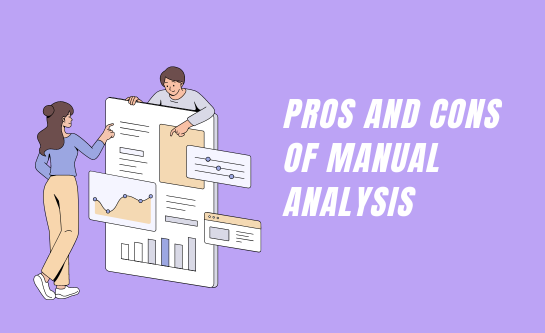Digital or Manual: Choosing the Right Method to Analyze Consumer Purchasing Process
 Jul 01st, 2024
Jul 01st, 2024
 637 views
4 MINS READ
637 views
4 MINS READ
Understanding the consumer purchasing process is crucial for any business aiming to excel in today’s competitive market. As technology continues to evolve, organizations are presented with a variety of methods to analyze this process. One of the primary decisions they face is whether to manually analyze consumer behavior or employ digital tools for the task. This blog post will explore the advantages and disadvantages of both approaches and guide on selecting the most suitable method to analyze the customer journey effectively.
Pros and Cons of Manual Analysis

Manual analysis of the consumer purchasing process entails human intervention, relying on observations, surveys, and interviews. Below, we delineate some of the pros and cons associated with this method:
Pros
1. In-depth Insight
Manual analysis facilitates the gathering of qualitative data through direct interactions with customers. Employing interviews and surveys, enterprises can glean profound insights into consumer preferences, pain points, and motivations.
2. Flexibility
Human analysts can adapt their approach based on the specific needs of the research. They can explore unforeseen avenues and pose follow-up questions to delve deeper into consumer behavior.
3. Personal Touch
Engaging with customers directly adds a personal touch to the analysis process. This can foster a sense of connection and trust, leading to more candid responses and valuable insights.
Cons
1. Time-consuming
Manual analysis can be a time-intensive process, requiring significant resources to conduct interviews, transcribe responses, and analyze data. This may not be feasible for businesses with limited time and manpower.
2. Subjectivity
Human analysts may introduce bias into the analysis process, consciously or unconsciously. Different analysts may interpret data differently, leading to inconsistencies in the findings.
3. Limited Scale
Manual analysis is inherently limited by the number of interviews or surveys that can be conducted. It may not capture a representative sample of the target audience, leading to skewed results.
Pros and Cons of Digital Analysis
Digital tools offer automated solutions for analyzing the consumer purchasing process, leveraging data analytics, artificial intelligence, and machine learning algorithms. The following are the pros and cons of this approach:
Pros
1. Efficiency
Digital tools can process large volumes of data quickly and efficiently, allowing businesses to analyze the customer journey at scale. This enables companies to identify patterns and trends in consumer behavior more effectively.
2. Objective Insights
Unlike humans, digital tools are not susceptible to bias. They can analyze data objectively, providing unbiased insights into consumer preferences and behavior.
3. Real-time Tracking
Digital tools can track consumer interactions in real-time across multiple touchpoints, providing businesses with up-to-date information on customer behavior. This enables timely interventions and adjustments to marketing strategies.
Cons
1. Lack of Context
While digital tools excel at processing data, they may lack the context that human analysts can provide. Without a deep understanding of the nuances of consumer behavior, businesses risk misinterpreting the data or overlooking important insights.
2. Complexity
Implementing and managing digital analytics tools can be complex and require specialized expertise. Businesses may need to invest in training or hire external consultants to harness the full potential of these tools.
3. Privacy Concerns
Collecting and analyzing large amounts of consumer data raises privacy concerns. Businesses must ensure compliance with data protection regulations and take measures to safeguard customer information.
How to Choose the Right Method?
Having delineated the pros and cons of both manual and digital methods for analyzing the consumer purchasing process, the pertinent question arises: How can enterprises discern the appropriate method for their requisites? Consider the following factors:
1. Research Objectives
Clearly define the objectives of your research. Are you aiming for in-depth qualitative insights or broad quantitative data? The complexity and scope of your research will dictate the choice of method.
2. Resources
Evaluate your available resources, encompassing budget, time, and expertise. While digital tools offer efficiency and scalability, they may entail upfront investment and technical acumen. Conversely, manual analysis may demand more resources but can furnish rich qualitative insights.
3. Target Audience
Contemplate the preferences and behaviors of your target audience. Are they technologically savvy and likely to engage with digital surveys, or do they prefer interpersonal interactions? Tailor your approach to align with the proclivities of your audience.
4. Integration
Assess how the chosen method integrates with your extant systems and processes. Digital tools should seamlessly integrate with your CRM and other data sources to provide a holistic view of the customer journey.
Wrap Up
Analyzing the consumer purchasing process assumes paramount significance for enterprises endeavoring to comprehend and cater to the needs of their clientele efficaciously. Whether opting to manually analyze consumer behavior or leverage digital tools, each approach harbors its respective advantages and challenges. By meticulously considering research objectives, resource allocations, target audience preferences, and integration imperatives, enterprises can judiciously select the method that best aligns with their exigencies and objectives. Ultimately, the crux lies in leveraging insights gleaned from the customer journey to inform decision-making and augment the overarching customer experience.
 Back to blog page
Back to blog page


























